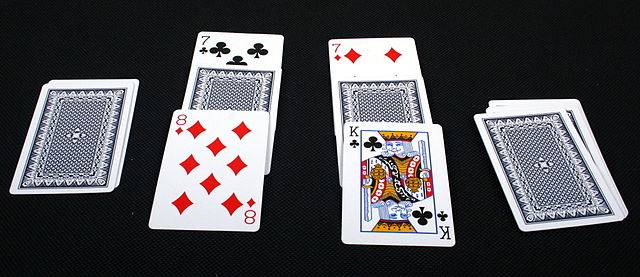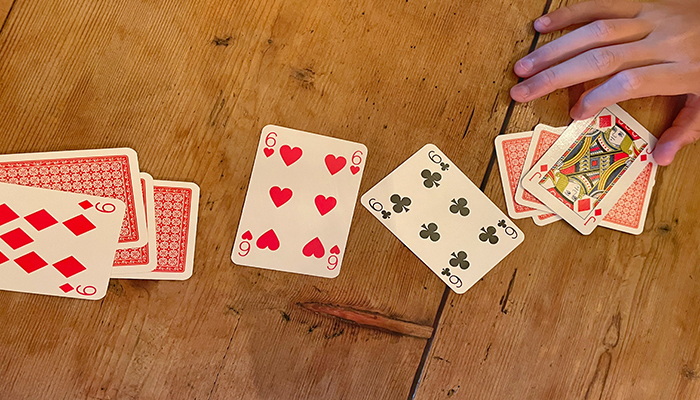Content Menu
● Overview of War
● Objective of the Game
● Setting Up the Game
● Playing the Game
● Handling Ties: "War"
● Ending the Game
● Strategies for Winning
● Variations of War
● Playing Tips for Kids
● Advanced Strategies for Adults
● Conclusion
● Frequently Asked Questions (FAQs)
>> 1. Can War be played with more than two players?
>> 2. What happens if I run out of cards during a war?
>> 3. Are there any strategies for winning at War?
>> 4. Can I play War with a modified deck?
>> 5. How long does a typical game of War last?
● Citations:
War is a classic card game that is simple to learn and can provide hours of entertainment for players of all ages. The game is typically played between two players, but it can also accommodate more. The objective is straightforward: to win all the cards in the deck. This article will guide you through the rules, strategies, and variations of the War card game, ensuring that you understand how to play and enjoy this timeless game.

Overview of War
War is played with a standard 52-card deck, where each card has a specific rank. The game does not require any special skills or strategies; it relies primarily on luck. Players take turns flipping cards from their decks, and the player with the higher card wins the round and takes both cards.
Objective of the Game
The goal of War is to collect all 52 cards in the deck. The game continues until one player has all the cards, making them the winner.
Setting Up the Game
To set up War, follow these steps:
- Gather Materials: You need a standard 52-card deck (remove jokers).
- Shuffle the Deck: Thoroughly shuffle the cards to ensure a random distribution.
- Deal Cards: Divide the deck evenly between the players, giving each player 26 cards face down.
Playing the Game
Once the setup is complete, you can begin playing:
- Start a Round: Both players simultaneously flip over the top card from their decks and place it face up on the table.
- Determine the Winner: The player with the higher-ranked card wins that round and collects both cards, placing them at the bottom of their stack.
- Card Rankings: The ranking of cards from highest to lowest is as follows:
- Ace (highest)
- King
- Queen
- Jack
- 10
- 9
- 8
- 7
- 6
- 5
- 4
- 3
- 2 (lowest)
Handling Ties: "War"
If both players reveal cards of equal rank, a "war" occurs:
1. Each player places three cards face down on the table.
2. Then, they flip over another card face up.
3. The player with the higher face-up card wins all cards involved in that war (the original tie plus the three face-down cards).
If there is another tie during this process, repeat these steps until one player wins.

Ending the Game
The game continues until one player has collected all of the cards in play. If a player runs out of cards during a war, they may use their last card as their face-up card for that war.
Strategies for Winning
While War is primarily a game of chance, there are some strategies that can improve your chances:
- Hold onto High Cards: Try to keep your aces and face cards for wars since they have a higher likelihood of winning.
- Observe Patterns: Pay attention to how your opponent plays; if they frequently win with certain ranks, adjust your strategy accordingly.
- Stay Calm: Maintain composure during wars; panicking can lead to poor decisions.
- Know When to Play Aggressively: If you notice your opponent has many low-ranking cards left, consider playing aggressively during wars to capitalize on their weaker hand.
- Practice Patience: Sometimes, it's best to play conservatively and wait for opportunities rather than rushing into every round or war.
Variations of War
War has several fun variations that can change gameplay dynamics:
- Three or More Players: The game can be played with three or four players by distributing cards evenly among all participants.
- Addition War: Players flip two cards at once and add their values together; the highest total wins.
- Peace: In this variation, instead of winning with high cards, players win with low ones.
- Double War: If there's a tie during a war, players place additional face-down cards before flipping another face-up card to determine the winner.
- Speed War: In this fast-paced version, players must quickly flip their top card without waiting for each other, adding an element of speed and excitement.
Playing Tips for Kids
War is an excellent game for children as it helps develop basic counting skills and understanding of numbers. Here are some tips to make it more enjoyable for younger players:
- Use Colorful Cards: Choose decks with bright colors or fun themes that appeal to kids.
- Explain Card Values Clearly: Make sure children understand which cards are higher and lower before starting.
- Encourage Friendly Competition: Remind kids that it's just a game and emphasize having fun over winning.
Advanced Strategies for Adults
For those looking to add depth to their gameplay experience, consider these advanced strategies:
- Card Counting: While it may not be as effective in War due to its randomness, keeping track of which high cards have been played can provide insight into what might still be in play.
- Psychological Play: Use bluffing techniques or feigned confidence when revealing high-ranking cards during wars to unsettle opponents.
- Team Play: Form teams when playing with multiple players; this adds an element of strategy as you coordinate with teammates against others.
Conclusion
War is an enjoyable and straightforward card game suitable for players of all ages. Its simplicity makes it easy to learn and play while its variations keep it fresh and exciting. Whether you're playing casually with friends or family or looking for a way to pass time while traveling, War is an excellent choice. With its reliance on luck and minimal strategy requirements, it offers a relaxed gaming experience that can be enjoyed by everyone involved.

Frequently Asked Questions (FAQs)
1. Can War be played with more than two players?
Yes, War can be played with three or more players by evenly distributing cards among all participants.
2. What happens if I run out of cards during a war?
If you run out of cards during a war, you may use your last card as your face-up card for that war.
3. Are there any strategies for winning at War?
While War relies on luck, holding onto high-ranking cards and observing your opponent's patterns can improve your chances.
4. Can I play War with a modified deck?
Yes! You can modify War by using fewer cards or including jokers as wildcards.
5. How long does a typical game of War last?
The duration varies widely; games can last anywhere from a few minutes to several hours depending on how many ties occur during play.
Citations:
[1] https://www.wikihow.com/Play-War-(Card-Game)
[2] https://en.wikipedia.org/wiki/War_(card_game)
[3] https://www.mplgames.com/blog/war-card-game/
[4] https://gameonfamily.com/play-war-card-game/
[5] https://bicyclecards.com/how-to-play/war
[6] https://www.pagat.com/war/war.html
[7] https://www.pokernews.com/card-games/war/how-to-play-war-guide.htm
[8] https://www.ducksters.com/games/war_card_game_rules.php
[9] https://www.youtube.com/watch?v=R70CSKNfOWQ
[10] https://playingcarddecks.com/blogs/how-to-play/war-game-rules
[11] https://www.youtube.com/watch?v=J5vT33Vo04s
[12] https://www.youtube.com/watch?v=R70CSKNfOWQ
[13] https://www.gamesforyoungminds.com/blog/war-card-game
[14] https://www.pokernews.com/card-games/war/war-strategy-tips.htm
[15] https://boardgames.stackexchange.com/questions/29287/what-variants-are-there-for-the-playing-card-based-game-war
[16] https://bicyclecards.com/how-to-play/war
[17] https://www.pagat.com/invented/war_vars.html
[18] https://scienceblogs.com/pontiff/2008/09/12/a-simple-strategy-for-the-card
































